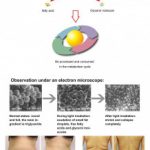?
Light therapy is a non-invasive treatment method that can be used to treat a variety of skin conditions. It involves exposing the skin to specific wavelengths of light to promote healing and rejuvenation. However, many people wonder if light therapy can also make them tan. In this discussion, we will explore the effects of light therapy on skin pigmentation and whether or not it can lead to a tan.
Contents
The Science Behind Light Therapy
Light therapy is a non-invasive treatment that uses specific wavelengths of light to improve mood, sleep, and skin health. It has been used for years to treat a range of conditions, including seasonal affective disorder (SAD), acne, and sleep disorders. The science behind light therapy is based on the idea that light exposure can affect the body’s circadian rhythm and stimulate hormones that regulate mood and sleep.
How Does Light Therapy Work?
Light therapy works by exposing the skin to specific wavelengths of light, typically blue or red light. Blue light has been shown to reduce inflammation and acne, while red light can promote collagen production and improve skin texture. The light is usually administered through a light box or a handheld device, and the treatment lasts for about 20-30 minutes per session.
Benefits of Light Therapy
Light therapy has numerous benefits, including improved mood, increased energy levels, and better sleep. It has also been shown to be effective in reducing the symptoms of seasonal affective disorder (SAD), a type of depression that occurs during the winter months. Additionally, light therapy has been used to treat acne, psoriasis, and other skin conditions.
Can Light Therapy Make You Tan?
One of the most common misconceptions about light therapy is that it can make you tan. However, this is not the case. Light therapy does not use UV light, which is responsible for tanning and skin damage. Instead, it uses specific wavelengths of light that are safe and non-damaging to the skin.
Light therapy is a safe and non-invasive treatment that can improve mood, sleep, and skin health by exposing the skin to specific wavelengths of light. This treatment uses visible light, not UV light, which means that it does not cause tanning or skin damage. Light therapy can benefit a variety of conditions, including acne, sleep disorders, and seasonal affective disorder (SAD). To use light therapy safely, it is important to consult with your healthcare provider, follow the instructions, use protective eyewear, and start slowly.
The Difference Between UV Light and Visible Light
UV light is a type of electromagnetic radiation that is responsible for tanning, sunburn, and skin damage. It is found in sunlight and tanning beds and is the primary cause of skin cancer. Visible light, on the other hand, is a different type of electromagnetic radiation that is responsible for the colors we see. It is safe and non-damaging to the skin.
Types of Light Used in Light Therapy
There are two types of light used in light therapy: blue light and red light. Blue light has a wavelength of 415-445nm and has been shown to reduce inflammation and acne. Red light has a wavelength of 630-660nm and can promote collagen production and improve skin texture. Neither of these types of light contains UV radiation, which means that they do not cause tanning or skin damage.
Misconceptions About Light Therapy
Despite the many benefits of light therapy, there are still some misconceptions about this treatment. One of the most common misconceptions is that it can cause tanning or skin damage. This misconception likely stems from the fact that tanning beds use UV light, which can cause skin damage and increase the risk of skin cancer.
Another misconception about light therapy is that it is only effective for seasonal affective disorder (SAD). While light therapy is an effective treatment for SAD, it can also be used to treat a range of other conditions, including acne, psoriasis, and sleep disorders.
One key takeaway from this text is that light therapy is a safe and non-invasive treatment that uses specific wavelengths of light to improve mood, sleep, and skin health. It does not use UV light, which is responsible for tanning and skin damage, and the two types of light used (blue and red) are safe and non-damaging to the skin. While light therapy is an effective treatment for seasonal affective disorder (SAD), it can also be used to treat acne, psoriasis, and sleep disorders. To use light therapy safely, it is important to consult with a healthcare provider, follow the instructions, use protective eyewear, and start slowly.
How to Use Light Therapy Safely
While light therapy is a safe and effective treatment, it is important to use it correctly to avoid any potential risks. Here are some tips for using light therapy safely:
1. Consult With Your Healthcare Provider
Before starting light therapy, it is important to consult with your healthcare provider to determine if it is right for you. They can also provide guidance on how to use the therapy correctly and safely.
2. Follow the Instructions
Be sure to read and follow the instructions that come with your light therapy device. This will ensure that you are using it correctly and safely.
3. Use Protective Eyewear
Some light therapy devices come with protective eyewear. If your device does not come with protective eyewear, be sure to wear sunglasses or other protective eyewear to avoid any potential damage to your eyes.
4. Start Slowly
If you are new to light therapy, start with shorter sessions and gradually increase the length of the sessions as your body adjusts.
FAQs: Does Light Therapy Make You Tan
What is Light Therapy?
Light therapy is a treatment that exposes your skin to different wavelengths of light to treat various skin conditions such as acne, psoriasis, and eczema, and to improve overall skin health.
Can Light Therapy Cause Tanning?
Light therapy can cause tanning, just like any other source of light. The frequency and intensity of the light used in light therapy may cause the skin to produce more melanin, which gives the skin its color. However, the extent to which light therapy causes tanning depends on the duration, frequency, and intensity of the light.
Should I be Concerned About Tanning During Light Therapy?
Tanning during light therapy is not necessarily a bad thing. In fact, some medical professionals use light therapy as a tanning alternative to minimize the harmful effects of UV radiation from the sun or tanning beds. However, if you are undergoing light therapy specifically to treat a skin condition and you notice increased tanning or skin damage, you should consult your healthcare provider immediately.
Can Light Therapy Protect Against Tanning?
Although light therapy can cause tanning, it can also help protect against tanning when used appropriately. For example, some types of light therapy have been shown to increase the production of melanin in the skin, which can provide some level of protection against UV radiation from the sun. Additionally, light therapy may provide a safer alternative to traditional tanning methods, as it does not expose the skin to harmful UV radiation.
Can Light Therapy Reverse Tanning?
Light therapy is not typically used to reverse tanning, as the skin’s tan is a natural and healthy response to sun exposure. However, it may be possible to use light therapy in combination with other treatments to help reduce the appearance of any skin damage caused by sun exposure or tanning. If you are concerned about the effects of tanning on your skin, consult with a qualified dermatologist or skincare professional.







